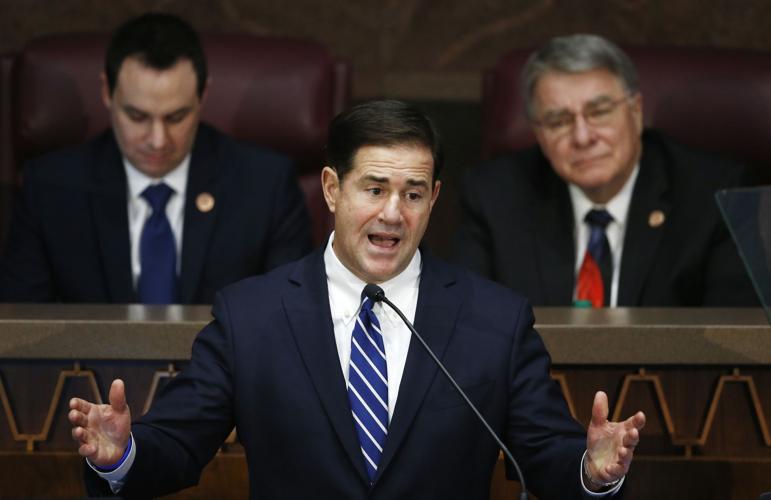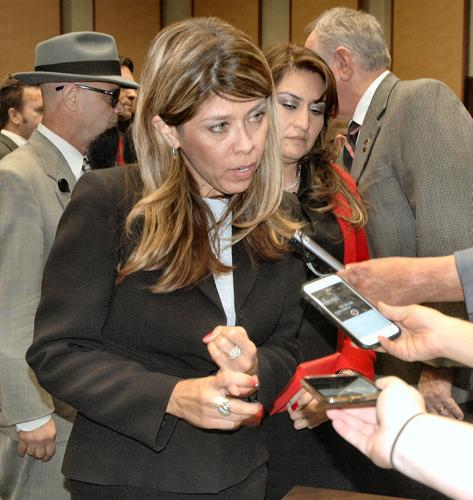PHOENIX — Gov. Doug Ducey promised more money on Monday for education.
But the Republican governor’s State of the State speech was short on details. And his call for bipartisan cooperation drew a skeptical response from Democrats who said that Ducey has yet to reach out to them.
In his 56-minute speech, Ducey also said he wants:
- A crackdown on opioid prescription abuse.
- Lower state income taxes for veterans who get military pensions.
- New mandatory sentencing laws for people who are drunk and go the wrong way on freeways.
The governor also said he is directing the state Department of Transportation to ensure that inmates about to be released from prison have a state-issued ID card. He said that will remove a major impediment to former prisoners being able to get back on their feet and get a job.
It was Ducey’s statement that he wants to reduce recidivism that allowed him to pivot into what is likely going to be the big debate of the session: How much more money to put into K-12 education.
“For too many years, Arizona saw spending on prison facilities go up, and spending on K-12 education go down,” the governor told lawmakers. That included Ducey himself, who in his first two years as governor sought dollars to construct and staff new facilities.
“Not any more,” he said, saying this is the second year he won’t ask for more dollars for the Department of Corrections.
And Ducey said that his top aides have identified “millions of wasteful spending.”
“Let’s spend these dollars — tens of millions of dollars combined — where they can go to better use: in our public schools and for our teachers,” he said.
But House Minority Leader Rebecca Rios called what she heard “short on substance.”
“I’m hearing that he’s going to do these things for education without any clear idea of how,” she said.
The governor’s bigger problem could be with the broader community of education advocates and some business leaders who say state aid to schools has been cut by a combined $1 billion-plus in the past decade.
Ducey boasted overall school spending is up 10 percent in the past three years, even adjusted for inflation. The governor did not say, though, that even when inflation is taken into account, Arizona spends less now per student than it did in 2007.
The governor provided no specifics about how much more he wants lawmakers to provide, steering the conversation away from dollars and cents.
“Some folks think the best argument for a greater investment in our public schools is to claim that our schools are failing,” the governor said. “They are wrong.”
He said the record shows that schools are improving.
“You wouldn’t always know it from picking up the newspaper or turning on the TV, but Arizona public schools are showing real, measurable signs of progress,” he said.
As proof, Ducey said four of the top five public high schools in America are in Arizona.
What Ducey did not mention, though, is that all four are charter schools. And while they technically are public schools that are supposed to be open to all students, they have come under increased scrutiny for admission policies that some say are exclusionary.
There are gains among traditional public schools, Ducey said, specifically citing the progress made in the Chandler Unified, Peoria Unified and Washington Elementary school districts.
“We know how to educate a child in the state of Arizona,” the governor said. “We need to do it more often in more locations across our state.”
TAX CUT
While the governor is not saying how much more he will put into education, he is proposing what would reduce state income tax collections by $15 million.
Current law exempts the first $2,500 of military pensions from state taxes, a figure the governor said has not been updated since 1989. He proposes increasing that in steps to $10,000, putting the average savings to a military retiree at $280 a year.
Rios is withholding judgment, saying cutting revenues can’t be enacted in isolation.
“You have to look at everything collectively,” she said. “If we continue to go down the same route of tax cuts every year at the expense of true investment in public education, then we continue to sit where we are now, which is dead last in the country for public education.”
OPIOID EPIDEMIC
Ducey spent more time in his speech on the hot-button issue of opioid abuse than on K-12 education.
“Since I last stood at this podium, we’ve lost more than 800 Arizonans to opioids,” the governor said. “These are real lives and real people, gone.”
“Families, marriages and lives torn apart, tragically and unexpectedly because of a potent drug misprescribed, overprescribed, and then, before you know it, is too late,” he said.
Ducey promised more details when he calls next week for a special legislative session to run concurrent with the regular session.
But Dr. Cara Christ, the state health director, already has provided some specifics.
She wants Arizona law to spell out that “opioid naive” patients should get no more than five days’ worth of pills at any one time. She said there is usually no need for anything more than that.
Christ said there is medical evidence that the chance of addiction increases sharply once patients take the pills for six or more days. And the governor himself said 75 percent of those addicted to heroin nationally got hooked with prescription opioids.
Whether lawmakers are willing to go along remains to be seen. There is no evidence that the medical community will agree to strict state-imposed limits on its prescription-writing privileges.
Ducey suggested he will do more than seek restrictions on doctors.
“This much I commit: All bad actors will be held accountable — whether they are doctors, manufacturers or just plain drug dealers,” the governor said.
That goes to Christ’s recommendations that the law be changed to allow prosecutors to go after manufacturers who unfairly and improperly market their drugs to doctors, allowing them to be charged as drug dealers.





